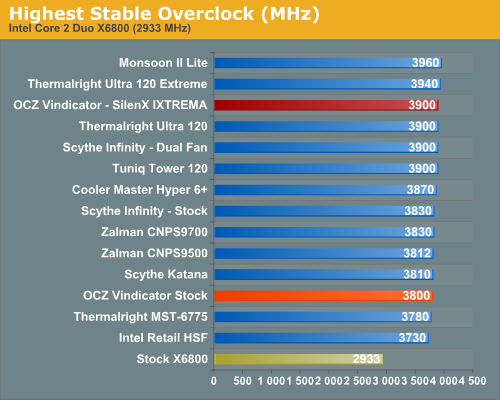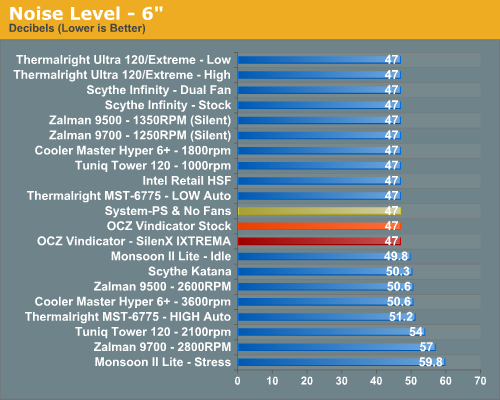OCZ Vindicator: Heatpipe Tower Cooling from OCZ
by Wesley Fink on April 5, 2007 4:00 AM EST- Posted in
- Cases/Cooling/PSUs
Overclocking
As cooling solutions do a better job of keeping the CPU at a lower temperature, it is reasonable to expect the overclocking capabilities of the CPU will increase. In each test of a cooler we measure the highest stable overclock of a standard X6800 processor under the following conditions:
CPU Multiplier: 14x (Stock 11x)
CPU voltage: 1.5875V
FSB Voltage: 1.30V
Memory Voltage: 1.90V
nForce SPP Voltage: 1.35V
nForce MCP Voltage: 1.7V
HT nForce SPP <-> MCP:
Auto
Memory is set to Auto timings on the 680i and memory speed is linked to the FSB for the overclocking tests. This removes memory as any kind of impediment to the maximum stable overclock. Linked settings on the 680i are a 1066FSB to a memory speed of DDR2-800. As FSB is raised the linked memory speed increases in proportion. The same processor is used in all cooling tests to ensure comparable results.

The OCZ Vindicator with the stock fan could only reach 3.80GHz overclock with stability. This result is average to below average among the tested heatpipe towers. However a change to the 72 CFM 14 dB-A SilenX IXTREMA 120 allowed us to push the overclock to 3.90GHz with complete stability. This matches the top tier of overclocks achieved by the Tuniq Tower 120, Thermalright Ultra 120/Scythe SFLEX, Cooler Master Hyper 6+, and Scythe Infinity with dual push-pull fans.
The only air cooler that has reached higher than 3.90GHz is the Thermalright Ultra 120 Extreme, which was featured at CeBIT. We managed 3.94GHz with that top air cooler. The hybrid TEC/air Monsoon II Lite reached 3.96GHz in benchmarking, but that cooler combines active TEC cooling with passive air cooling and would be expected to reach higher overclocks than an air-only solution
Noise
For many enthusiasts upgrading cooling the goal is maximum stable overclock, and they will live with the inconvenience of a louder system. For other users silence is the most important factor, and these users will forgo maximum overclocking if that increases system noise levels.
We measured noise levels with the OCZ Vindicator with both stock and SilenX IXTREMA fans under both load and idle conditions. As might be expected with fans with noise ratings of 18.5 dB-A and 14 dB-A, the measured noise was below our system noise floor at both 6" and 24" positions above the open side of our system case.
There are virtually no power supplies that do not have a fan. While Zalman and a few others do make an expensive fanless power supply, we have not seen a fanless unit larger than 500W, or one that would be used for seriously overclocking a system. With that in mind the noise level of the system with all fans turned off except the power supply was measured. The power supply used for the cooling test bed was the OCZ PowerStream 520, which is one of the quieter of the high performance power supplies.
We have also measured the Corsair 620 watt and Mushkin 650 watt power supplies which are reported to be quieter than the OCZ. Both the Corsair and Mushkin are indeed quieter at idle or start up speed. However as soon as load testing begins and the PSU fan speed kicks up and the measured noise level is almost exactly the same as the OCZ PowerStream 520 watt power supply. In keeping with our "real world" philosophy of noise, we consider the PSU load noise to be the more realistic noise level of power supplies. We do plan to evaluate additional power supplies and configurations in our upcoming 120mm fan roundup, but we will tilt to real world rather than procedures that test fans on foam blocks or hard drive noise with their "noisy" side pointed toward a foam block.
The noise level of the power supply was 38.3 dB from 24" (61cm) and 47 dB from 6" (152mm). The measured noise level of the test room is 36.4 dB, which would be considered a relatively quiet room with a noise floor slightly below the OCZ PowerStream 520 PSU.


Measured noise levels in this chart should be considered worst case. Measurements were taken with an open side of a mid tower case 6" and 24" from the HSF. Real world would be a completely closed case resulting in a further reduction in noise.
Any 120mm fan should be mountable on the OCZ Vindicator. The fan clips connect to the outside mount hole, which means both open post and the more common closed post fans will work properly. The stock OCZ fan is closed post and the SilenX is open post. This means the SilenX will work on any cooler we have reviewed thus far - including the Thermalright Ultra 120 and Ultra 120 Extreme.
As cooling solutions do a better job of keeping the CPU at a lower temperature, it is reasonable to expect the overclocking capabilities of the CPU will increase. In each test of a cooler we measure the highest stable overclock of a standard X6800 processor under the following conditions:
CPU Multiplier: 14x (Stock 11x)
CPU voltage: 1.5875V
FSB Voltage: 1.30V
Memory Voltage: 1.90V
nForce SPP Voltage: 1.35V
nForce MCP Voltage: 1.7V
HT nForce SPP <-> MCP:
Auto
Memory is set to Auto timings on the 680i and memory speed is linked to the FSB for the overclocking tests. This removes memory as any kind of impediment to the maximum stable overclock. Linked settings on the 680i are a 1066FSB to a memory speed of DDR2-800. As FSB is raised the linked memory speed increases in proportion. The same processor is used in all cooling tests to ensure comparable results.

The OCZ Vindicator with the stock fan could only reach 3.80GHz overclock with stability. This result is average to below average among the tested heatpipe towers. However a change to the 72 CFM 14 dB-A SilenX IXTREMA 120 allowed us to push the overclock to 3.90GHz with complete stability. This matches the top tier of overclocks achieved by the Tuniq Tower 120, Thermalright Ultra 120/Scythe SFLEX, Cooler Master Hyper 6+, and Scythe Infinity with dual push-pull fans.
The only air cooler that has reached higher than 3.90GHz is the Thermalright Ultra 120 Extreme, which was featured at CeBIT. We managed 3.94GHz with that top air cooler. The hybrid TEC/air Monsoon II Lite reached 3.96GHz in benchmarking, but that cooler combines active TEC cooling with passive air cooling and would be expected to reach higher overclocks than an air-only solution
Noise
For many enthusiasts upgrading cooling the goal is maximum stable overclock, and they will live with the inconvenience of a louder system. For other users silence is the most important factor, and these users will forgo maximum overclocking if that increases system noise levels.
We measured noise levels with the OCZ Vindicator with both stock and SilenX IXTREMA fans under both load and idle conditions. As might be expected with fans with noise ratings of 18.5 dB-A and 14 dB-A, the measured noise was below our system noise floor at both 6" and 24" positions above the open side of our system case.
There are virtually no power supplies that do not have a fan. While Zalman and a few others do make an expensive fanless power supply, we have not seen a fanless unit larger than 500W, or one that would be used for seriously overclocking a system. With that in mind the noise level of the system with all fans turned off except the power supply was measured. The power supply used for the cooling test bed was the OCZ PowerStream 520, which is one of the quieter of the high performance power supplies.
We have also measured the Corsair 620 watt and Mushkin 650 watt power supplies which are reported to be quieter than the OCZ. Both the Corsair and Mushkin are indeed quieter at idle or start up speed. However as soon as load testing begins and the PSU fan speed kicks up and the measured noise level is almost exactly the same as the OCZ PowerStream 520 watt power supply. In keeping with our "real world" philosophy of noise, we consider the PSU load noise to be the more realistic noise level of power supplies. We do plan to evaluate additional power supplies and configurations in our upcoming 120mm fan roundup, but we will tilt to real world rather than procedures that test fans on foam blocks or hard drive noise with their "noisy" side pointed toward a foam block.
The noise level of the power supply was 38.3 dB from 24" (61cm) and 47 dB from 6" (152mm). The measured noise level of the test room is 36.4 dB, which would be considered a relatively quiet room with a noise floor slightly below the OCZ PowerStream 520 PSU.


Measured noise levels in this chart should be considered worst case. Measurements were taken with an open side of a mid tower case 6" and 24" from the HSF. Real world would be a completely closed case resulting in a further reduction in noise.
Any 120mm fan should be mountable on the OCZ Vindicator. The fan clips connect to the outside mount hole, which means both open post and the more common closed post fans will work properly. The stock OCZ fan is closed post and the SilenX is open post. This means the SilenX will work on any cooler we have reviewed thus far - including the Thermalright Ultra 120 and Ultra 120 Extreme.










41 Comments
View All Comments
Spoelie - Thursday, April 5, 2007 - link
I would also like to know a more quantifiable difference between the stock fan and this silenx fan. The noise measurements are kinda useless since they put everything on the same level. But do they actually sound all the same? Is the silenx really quiter?? Would be kinda strange.So even if it is like (this one sounds louder as that one, and when i put my hand before them i can feel more air move with this one than with this one) than we can at least confirm what each fan does, just not by how much. The only thing we know at this moment is that the silenx moves more air, judging by the temperatures.
silentpcreview is really good, but the focus on these articles is different, they're more geared to overclocking. So while some critique is valid, this article is not trying to be a definite one on the noise front or a competitor to what silentpcreview does.